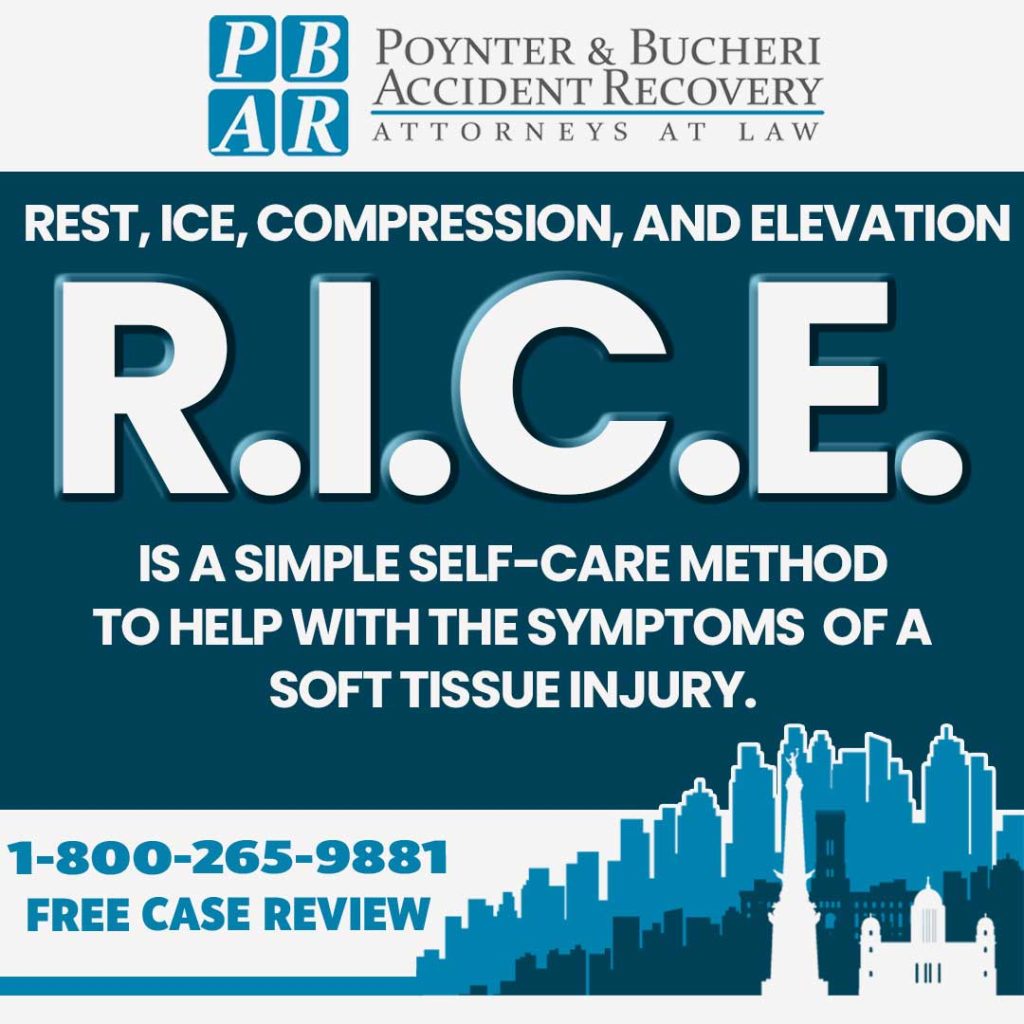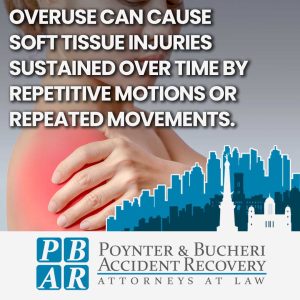
What Is a Soft Tissue Injury?

Soft tissue injuries damage the body’s nerves, muscles, ligaments, and tendons. There are two types of injuries: acute injuries and overuse injuries.
Acute injuries occur as the result of “sudden trauma” like a car accident, workplace accident, fall, or pinch injury. Whiplash is one of the most common types of acute injury accident cases.
Overuse can cause soft tissue injuries sustained over time by repetitive motions or repeated movements. The challenge is many of them are not perceptible to others as other wounds like burns, abrasions, broken bones, or fractures might be.
Are Soft Tissue Injuries Serious Enough to Seek Compensation?

Even though tissue injuries might not show up on an X-ray or have visible signs of injury, soft tissue injuries can cause chronic pain and long-term impairments for soft tissue injury victims; unfortunately, insurance companies aggressively fight personal injury claims involving soft tissue injuries.
Some may think that soft tissue injuries are not as severe or life-altering as more apparent injuries; that is not the case for suffered soft tissue injuries. Most soft tissue injuries can result in intense pain lasting from several days to weeks to even chronic, lifelong discomfort and severe pain.
What Could My Soft Tissue Injury Claim Compensation Include?

To win their soft tissue injury claim, victims have to prove that their specific circumstances were due to someone else’s negligence and that they suffered severe soft tissue injuries.
Whether a work injury, neglected property, or car accident caused your soft tissue injuries, the liable party’s insurance company could be required to pay for:
Medical Expenses: Coverage for diagnostic tests (CT scans, MRIs), emergency medical care, physical therapy, surgeries, ongoing treatments, and other medical expenses.
Lost Income: Compensation for lost income you didn’t earn during the recovery period due to an inability to work.
Pain and Suffering: Noneconomic damages addressing the physical and emotional distress caused by the soft tissue damage or injury.

Emotional Distress: Compensation for psychological impact, anxiety, and mental anguish.
Diminished Quality of Life: Acknowledgment and compensation for the negative impact on the individual’s well-being and everyday activities.
Rehabilitation Costs: Financial coverage for rehabilitation services necessary for recovery. These can be extensive in severe cases where victims require surgery.
Property Damage: In cases where personal property (e.g., motor vehicle accidents only) is damaged during the incident, compensation for repair or replacement costs.
Out-of-Pocket Expenses: Reimbursement for any additional costs incurred due to the injury, such as transportation to medical appointments or necessary medical equipment.
Loss of Consortium: Compensation for the loss or reduction of normal activities in a relationship like companionship or intimacy with a spouse or partner.
Legal Fees: In some soft tissue injury cases, your legal claim compensation may cover legal fees associated with pursuing your personal injury claim, mainly if the services of a soft tissue injury lawyer are engaged.
Personal injury cases, civil court, and navigating the legal system are complicated. It’s nearly impossible for accident victims to successfully file a personal injury lawsuit claim and win compensation from liable parties.
If you’ve suffered a soft tissue injury, call 1-800-265-9881 or (317) 780-8000 or contact our legal team online to request your free consultation with an experienced Indiana personal injury attorney.
Common Causes of a Soft Tissue Injury
Whiplash and most other soft tissue injuries, such as sprains, strains, contusions, and more, can result from a variety of causes, including:
- Car accidents
- Truck accident
- Motorcycle crashes
- Bicycle and pedestrian accident
- Slip and fall accidents
- Carpal Tunnel Syndrome
- Workplace accidents
- A dog bite or dog attack
- Repetitive motion tasks
- Pinch or crush accident
- Boating accident
- ATV accident
- DUI accident
Signs of Soft Tissue Damage

- Pain: Immediate or delayed onset of pain at the injury site.
- Swelling: Inflammation leading to visible or palpable swelling.
- Stiffness: Limited range of motion, especially noticeable after rest.
- Tenderness: Localized sensitivity or pain upon touch in the injured area.
- Muscle Spasms: Involuntary contractions of muscles in the affected area.
- Restricted Movement: Difficulty moving the injured body part.
- Fatigue: Increased tiredness or exhaustion, especially with prolonged discomfort.
- Headaches: Common in soft tissue injury, especially whiplash.
- Referred Pain: Discomfort felt in an area away from the injury site.
- Difficulty Bearing Weight: Challenges in putting pressure or weight on the affected area.
What Are The Most Common Soft Tissue Injuries?
Whiplash:

Whiplash is a neck injury where your head is jerked violently backward and forward, such as in a rear-end car crash or fall. Whiplash often results in neck pain, stiffness, headaches, muscle tenderness, particularly in the shoulders and back, fatigue, sleep problems, blurred vision, tinnitus, and more.
Sprains:
Sprains are caused by the tearing or stretching of a ligament between two bones, most often seen in the ankle, wrist, knee, and thumb. Sprains are common in a slip and fall injury case and automobile or bicycle accidents. Sprains have grades of severity, ranging from mild to severe.
Strains:
Often confused with sprains, strains are caused by the tearing or stretching of a tendon, which connects tissue to a muscle or of the muscle itself. Legs, ankles, hands, and elbows are susceptible to acute and chronic strains.
Contusions:
A contusion is a medical term for a bruise, which occurs when a capillary or blood vessel leaks blood into the surrounding area, resulting in a hematoma or collection of blood under the skin. Contusions can occur to muscle, skin tissue, and bone and can develop quickly or over several hours after sustained injury.

Bursitis:
Bursitis is the irritation or swelling of the bursa, a fluid-filled sack between a bone and the tendon or muscle cushions joints. Bursitis is common in the elbow, shoulder, knee, hip, heel, or big toe. Often the result of overuse, bursitis also can occur due to an injury such as a fall, car accidents, or trauma to the joints.
Tendonitis:
Tendonitis, sometimes spelled tendinitis, is caused by the inflammation of a tendon. When the covering of a tendon, or its sheath, is inflamed, it is called tenosynovitis. Often, the two can occur together and result from a sudden injury or trauma.
Tears:
Also referred to as ruptures, tears can occur in tendons or muscles and can be complete or partial and can be serious soft tissue injuries. This type of injury often happens when forced movements stretch muscles in unusual ways.
Hernias:
Hernias are when “an organ pushes through an opening in the muscle or tissue that holds it in place” and often involve the abdomen. Hernias can occur as the result of an injury or as the result of surgery. Though rarer, hernias called traumatic abdominal wall hernias can occur from accidents involving motor vehicles, bikes, and even animals and have occurred in both adults and children.
The Seriousness of Soft Tissue Injuries

According to the Merck Manual, soft tissue injuries like sprains, strains, and tears can result in complications that, while unusual, could even lead to permanent limb dysfunction.
The Merck Manual lists the following as acute complications from such soft tissue injuries:
- Bleeding
- Injuries to the vascular system
- Injuries to the nervous system
- Compartment syndrome
The Merck Manual lists the following as long-term complications from common soft tissue injuries such as sprains, strains, and tears to tendons:
- Joint instability
- Impaired range of motion
- Post-traumatic stiffness
- Osteoarthritis
Beyond the physical, emotional, and mental pain, soft tissue injuries may cause, the medical bills, lost wages, and other losses caused by a soft tissue injury can be substantial.
I Have Suffered Soft Tissue Damage. Can I Pursue Compensation?

Proving a soft tissue injury can be difficult, so an insurance company typically works hard to avoid paying soft tissue injury claims. Without an experienced personal injury attorney, you may not receive the financial compensation you deserve for your injury.
You and your loved ones deserve a fight for your rights. Poynter & Bucheri, LLC, has the trained soft tissue injury lawyers to help you get the financial compensation you deserve from your personal injury claim.
If you are involved in a personal injury accident, see a physician as soon as possible. Do not immediately assume that you are fine, even if you are in an Indiana car accident and your vehicle is undamaged. Many severe soft tissue injuries will show symptoms hours to days after you’ve suffered a soft tissue injury.
This is why seeking medical attention after an injury or car accident is essential. If the symptoms appear later, you can contact your physician for further diagnosis and treatment and have a record of seeking treatment.
Talk to Our Legal Team About Your Soft Tissue Injury Case!
Visit our contact page to request a free case review by completing our contact form and getting directions to our office. You can chat with a representative 24/7 online to get the help you need now!
Call 1-800-265-9881 or (317) 780-8000 to schedule your free soft tissue injury claim case review. You may also be able to obtain compensation for your physical pain, emotional suffering, and other noneconomic damages. Learn about your legal rights to hold negligent parties responsible and liable for soft tissue injuries under Indiana’s personal soft tissue injury claim laws.
Seek Compensation with Indianapolis Soft Tissue Injury Attorneys
Suppose you suffer a soft tissue injury or accident caused only by negligent, careless, or reckless acts of another person or party. In that case, our Indiana personal injury lawyers may be able to help you. Your first step is to contact Poynter & Bucheri, LLC’s law firm for a free consultation with an experienced personal injury lawyer. You may have the legal right to recover substantial compensation for your medical bills, lost wages, pain, and suffering. Call our attorneys at 1-800-265-9881 or (317) 780-8000 to schedule your free case review and consider a soft tissue injury claim.
Video Transcript
Hi. I’m Rich Bucheri from Poynter & Bucheri, and today, I want to talk to you about soft tissue injury victims and what you need to know about soft tissue injuries. When talking about soft tissue injuries, we’re talking about injuries to the muscles, ligaments, or tendons; serious injuries are often caused by sudden force applied to those soft tissues.
If you have hyper-flection or hyperextension of those tissues, it can cause microscopic tears, which then become inflamed and cause pain. Often, when those soft tissues are repaired, it leaves scarring, which can also become inflamed and cause problems because they are not as elastic or flexible as the uninjured soft tissue.
And so, what we often find in soft tissue cases is that these injuries don’t manifest themselves for a day or two after the car accident itself. You get in a vehicle accident, and the police officer comes to the scene, and they ask if you are fine and you feel okay, so you don’t tell them you have any problems. You don’t go in the ambulance to the hospital to get checked out. Instead, you end up just going home feeling all right. Maybe your adrenaline starts to wear off, and the following day, you wake up and can’t get out of bed. And so, it is common for my clients to say they didn’t feel any problem for a day or two.
The problem is, depending on how the ligaments, muscles, or tendons heal and whether any therapy is used to ensure they heal correctly, these problems can last for months and months. The scar tissue that repairs these types of injuries may never be as muscular as the original ligaments, tendons, and muscles. And so, you may have a permanent injury from this situation.
It’s essential to get immediate medical attention as soon as you start feeling pain so that somebody can take a look at your situation and determine whether you need physical therapy or some other type of medical attention to ensure you can get your soft tissue injury under control.
